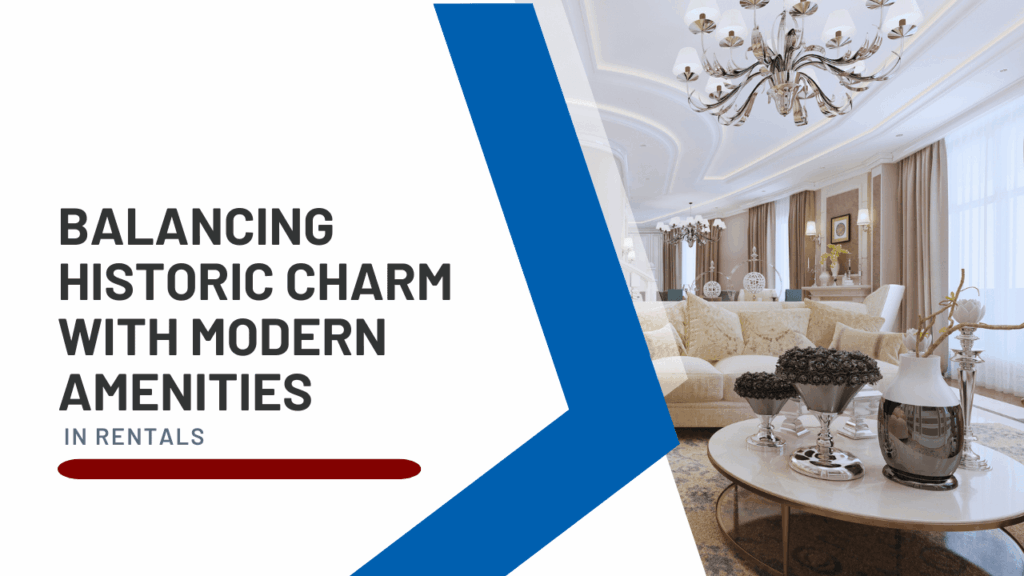
How to make a historic rental property in San Francisco modern and appealing to tenants who want the best amenities?
It’s hard to imagine smart-home technology in a Victorian home that was built in the late 1800s.
And yet, most tenants today are looking for fast internet services, energy-efficient everything, and a sense that they’re enjoying the convenience of modern amenities. But, no one is in a hurry to tear down more than a century of history, either. There has to be a balance when it comes to embracing and preserving historic charm while also providing modern amenities.
But, it’s not necessarily going to be easy. If you’re a real estate investor or a rental property owner who loves renting out their classic home, pay attention to what we recommend as you move forward with renovations and upkeep. Thanks to technology, it’s not so hard to preserve the authenticity of your property while still providing air conditioning, in-unit laundry, and smart home tech.
Embracing the Appeal: Design and Historical Significance
San Francisco’s Victorian and Edwardian homes are more than just living spaces; they’re iconic fixtures in a city that values its history and beauty. Residents and visitors admire their intricate woodwork, stained glass windows, and unique color and design elements.
You must know that as a rental property owner, highlighting these architectural details can set your property apart in a crowded market. However, the charm of history does not satisfy all the needs of contemporary living. How do you offer the comfort and functionality modern renters expect while also preserving the historical essence that makes your property unique?
Before delving into preservation methods and balancing that need for some modernity, it’s crucial to understand why San Francisco’s historical homes matter to the market and the people who live here. They not only provide a visual narrative of the local history that has been carefully preserved, but also contribute significantly to the region’s cultural identity and sense of community. Tourists come from all over the world to visit San Francisco. They’re not coming for a bunch of modern buildings.
Tourism bolsters the local economy. Additionally, these historic homes and buildings offer a glimpse into the architectural techniques and design preferences of past eras, enriching our understanding of societal progress.
When real estate investors understand and appreciate the social and economic benefits of preservation, it fosters a sense of responsibility towards these properties. They become more than just investments; they transform into legacies worth preserving.
As San Francisco property managers, we want to embrace those same intentions and help you to preserve and even promote the value of these very special homes.
Enter the Need for Modern Amenities
This is 2024, and convenience is everything.
Tenants want technology, they want energy-efficiency systems and appliances, and they want sustainability. Tenants are looking for rental homes that provide parking and accommodate pets. They want space, especially if they’re remote workers or moving in with an entire family.
You’ll need to maintain historic character even while you modernize your rental home.
You don’t necessarily want to tear down the history of a building or a home in order to facilitate video doorbells and stronger WiFi. But there has to be a balance between historic charm and modern comforts.
For historic properties, this often means retrofitting interiors and potentially making structural adjustments to cater to these needs without diminishing the property’s historical integrity.
Here are some of the most common updates and renovations that we see owners of historic homes making in order to provide modern amenities and conveniences:
- Tech Upgrades: Wi-Fi boosters and smart locks can be added without altering the property’s facade. These smart home features provide convenience and appeal to tech-savvy renters.
- Kitchen and Bath Revamps: While the heart of the home, the kitchen can be modernized with energy-efficient appliances and updated fixtures that reflect the era’s style while providing modern performance.
- Laundry Solutions: If space allows, in-unit washer and dryer installations add immense value. For tighter spaces, compact or stackable units that fit within existing layouts are excellent alternatives.
- Energy Efficiency: Incorporating energy-efficient solutions such as LED lighting and updated heating systems complements San Francisco’s green-conscious lifestyle without compromising the home’s historical aesthetics.
High-speed internet, smart home technology, updated kitchens, and in-unit laundry facilities rank high on the list of sought-after amenities. They don’t have to diminish the historic significance of your property.
Tips on Preserving Historical Charm
It’s vital to be aware that historical properties often come with a set of regulatory guidelines aimed at preserving their character. Before making any changes, consult with local preservation societies and city ordinances to understand what modifications are permissible. Familiarize yourself with The Mills Act, and find out whether your property is listed as a historic resource.
According to the California Environmental Quality Act (CEQA), all buildings constructed over 50 years ago and possess architectural or historical significance may be considered potential historic resources. That means proposed changes to these buildings may require some level of environmental review. CEQA review is a state-mandated process that, in part, determines whether a building is or is not considered a historic resource, and whether the proposed changes will have a negative impact on the resource.
You’ll want to partner with a Historical Preservation Technical Specialist before you begin any work.
You will need to:
- Respect the architecture. This means maintaining the original architectural elements when you can, especially if they showcase the property’s era. When making repairs and upgrades, contract with experts who have access to restorative methods that retain the building’s character while reinforcing its structure.
- Keep all décor and design appropriate for the property’s time period. You can highlight features like exposed brick or original hardwood floors. Not only does this preserve the history of your property, but it also appeals to tenants who are looking for special décor and unique finishes and features. Consider using antique or vintage fixtures and elements that complement the historical theme. When you’re replacing drawer pulls and cabinet knobs, for example, don’t go straight to the shiny, modern nickel. Choose something that looks older but still functions in a way that’s easy and modern.
If you’re investing in a property that’s historic or special to the city, you may want to partner with local historians to get a deeper appreciation of what you’ve purchased.
Maintenance and Restoration Best Practices
Maintaining and restoring historical homes requires a willingness to invest in historical accuracy. You will be expected to use appropriate materials. You’ll need to carry with you a sensitivity to the structure’s original intent.
We have developed some best practices in property management for maintaining and renovating these homes with the respect they deserve:
- Prioritize Routine Property Inspections
Implement a schedule of regular inspections by professionals with experience in historic preservation. When you’re going to do work, ask for an inspection from someone familiar with historic construction methods. Inspections may reveal signs of wear, deterioration, or small infestations that can quickly grow and cause significant damage. Frequent inspections can eliminate the threat and potential expense of deferred and unreported maintenance.
- Focus Repairs on Preventative Maintenance
Routine maintenance tasks such as repainting, re-caulking, and resealing are essential for preserving the building’s condition. Make sure you are regularly cleaning out gutters and chimneys. Protect your drainage system against moisture, which any expert will tell you is a common enemy of historical structures. These are preventative maintenance measures you’d take with any rental home, but they become more urgent when we’re talking about the preservation of historic buildings.
- Be Smart When Incorporating Modern Amenities and Features
While modern conveniences are necessary for tenants, they must be integrated in a way that does not compromise the original character of the home. Original structural elements and architectural details should be preserved whenever possible.
If you decide that updates are required, they should be made with historical sensitivity, using materials and designs in line with the home’s era. There are specialists who know how to do this with care, and while their services might require more of an investment, the results will be worth the effort. Property managers in San Francisco can also negotiate the best rates and partner with the best service providers and vendors.
Historical Restoration
 Property managers can be a great resource. For example, when restoration is needed due to age-related issues, your property manager can set up a consultation with a preservation specialist. We work with professionals who can guide you on the appropriate techniques and materials to restore the home as closely as possible to its original state.
Property managers can be a great resource. For example, when restoration is needed due to age-related issues, your property manager can set up a consultation with a preservation specialist. We work with professionals who can guide you on the appropriate techniques and materials to restore the home as closely as possible to its original state.
Don’t forget your responsibility to the community. Your property isn’t just a rental home, it’s also a part of San Francisco’s history. Many owners find themselves asked to open their doors to historical societies, local historians, and educational groups. Be willing to do this if your tenants are on board. We always recommend that with a historic home, you focus on long-term tenancies rather than short-term rentals, which can create more deterioration.
Recognizing the dual responsibility of providing what your tenants want with preserving the historic authenticity of your property is key to ensuring a successful rental experience.
Let’s talk about your historic home. Contact us at Sharevest Property Management.